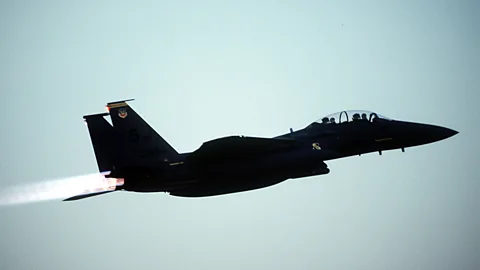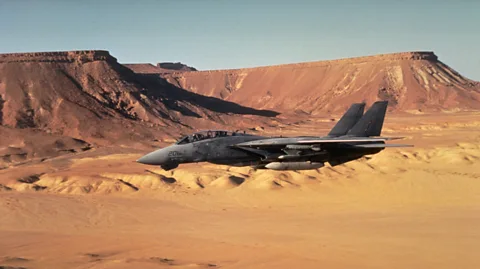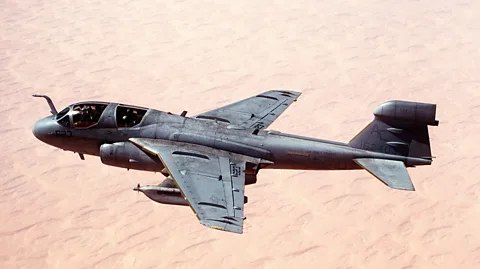The drug pilots take to stay awake
 Getty Images
Getty ImagesPilot fatigue is in the spotlight this week, after the news that one Indonesian flight had two sleeping pilots at its helm. But military organisations have been grappling with this problem for decades – and they have a surprising solution.
The intriguing tablets were discovered in a Nazi's pocket. The pilot had been shot down over Britain in a bombing raid during World War Two – along with the remains of his methamphetamine supply. At the time, this was the Luftwaffe's favourite pick-me-up for fatigued airmen, known as "pilot's salt" for its liberal application. But though the allied forces suspected this, they didn't know for sure.
The pharmacological souvenirs were promptly shipped off for testing, and soon the British were working on their own version. The resulting stimulant was widely distributed, and fuelled hundreds of late-night missions across Europe. But this was just the beginning. A related drug, dextroamphetamine, again became popular during the Gulf War in 1990-91, when it was taken by the majority of fighter pilots involved in the initial bombardments on Iraqi forces in Kuwait. Today this pill is still in use by US military aircrews. They use it to solve the same problem, pilot fatigue, which can creep up on aviators during long missions and compromise their safety.
But there's a catch. Amphetamines can be highly addictive – and even in the 1940s they were widely abused. So, in recent years, military organisations have been on the hunt for another option.
Enter modafinil, a stimulant originally developed for the treatment of narcolepsy and excessive daytime drowsiness in the 1970s. It didn't take long for people to discover that, while the drug can help to prevent people from falling asleep, it can also have powerful effects. The medication has been shown to improve spatial planning, pattern recognition, and working memory, as well as boosting overall cognitive performance, alertness, and vigilance in situations of extreme fatigue.
Modafinil has its own flaws. Side effects can include sweating, pounding headaches, and even hallucinations. Depite these risks, in certain circumstances it can be a formidable aid for those who need to stay awake. In one early study the drug kept people alert for up to 64 hours of activity, and its effects have been compared to drinking 20 cups of coffee. How does it work? And why is it used?
A powerful stimulant
In the world of fighter pilots, there are two kinds of drugs: go-pills and no-go pills. The former are stimulants, and increase the activity of the central nervous system – one reason amphetamines are sometimes known by the street name "speed". The latter are depressant substances, which slow down the transmission of messages between the brain and the body. In situations where the timing of alertness and sleep is critical, air forces sometimes use these medications to command the body into cooperation. So, along with an arsenal of sleep aids, this is where modafinil comes in.
Modafinil is already widely available – approved for use by air forces in Singapore, India, France, the Netherlands, and the United States. Meanwhile, an investigation by the Guardian newspaper in the UK revealed that a substantial cache of the drug had been purchased by the UK Ministry of Defence ahead of the beginning of the war in Afghanistan in 2001. Another order had been secured in 2002, before the invasion of Iraq, Though a defence research agency conducted experiments with the pills, they were reportedly not used on combat personnel.
 Getty Images
Getty ImagesIn fact, chemically enhanced airmen have been involved in hundreds of military operations over the last decade alone.
As they flit about the sky, fighter pilots often have just a few seconds to observe their surroundings and decide how to react to threats, so tiredness can easily be fatal. But oddly, intense flights involving serious warfare or manoeuvres are not the only ones where pilots tend to struggle with lack of sleep – in fact, boring flights come with their own challenges.
"If you're just observing, five hours feels way longer than when you're doing a combat mission," says Yara Wingelaar-Jagt, a lieutenant colonel and head of the aerospace medicine department at the Dutch Ministry of Defence in Soesterberg, the Netherlands. In fast-paced situations, the body produces its own stimulant drug, adrenaline, which increases alertness and reduces feelings of fatigue – at least in the short-term. On the other hand, less engaging missions might lead to boredom, which could emphasise the impact of exhaustion.
The commercial airline pilots who fell asleep
In January 2023, two pilots boarded an Airbus A320 with 153 passengers and crew onboard. One asked his co-pilot to take over the control of the plane while he napped, and the other agreed. But it didn't go to plan. In March 2024, a report by Indonesia's National Transportation Safety Committee (KNKT) revealed that the fight from South East Sulawesi to Jakarta had effectively been pilot-less for 28 minutes, after both pilots fell asleep simultaneously. The incident has prompted a national inquiry, and highlighted the issue of pilot fatigue in commercial operations.
"A couple of years ago, when our test pilots had completed a new mission, they complained that the then-current fatigue countermeasure, caffeine, was not sufficient," says Wingelaar-Jagt. "They wanted something else to help them stay awake during the flight."
To find out if modafinil might be the answer, Wingelaar-Jagt and colleagues conducted a randomised controlled trial. Volunteers at the Royal Netherlands Air Force were kept up for 17 hours and then either offered a dose of modafinil, caffeine or a placebo. Next, they were assessed for their vigilance and sleepiness. The researchers found that both caffeine and modafinil were effective, though the latter worked for longer.
Even after an entire night without sleep, some people who took the drug felt that they could probably keep going for another day, she says. "Because of the modafinil, they felt definitely less fatigued and felt more alert," says Wingelaar-Jagt
It's not just pilots who may suffer from the effects of sleep deprivation in a military context. To complete certain operations successfully, the crew, particularly on helicopters, might also include a door gunner – someone whose job it is to direct and fire weapons – as well as loadmaster to load and unload important cargo. On the ground, there will always be air traffic controllers to help pilots take off and land.
A tricky dilemma
Of course, there are serious ethical and legal implications involved with offering stimulants like modafinil to military personnel. What would happen if someone refused to take a drug deemed necessary for the success of a mission?
 Getty Images
Getty ImagesOne study on the potential challenges of allowing stimulants in the Canadian armed forces highlights the following contradiction: while it's not legal to force someone to take a medication in Canada, it is a legal requirement for military personnel to perform "any functions that they may be required to perform" any time, day or night. If it was deemed necessary for someone to take modafinil for operational reasons, they could refuse, but they don't have the right to fail as a result. And the stakes may be high: falling asleep on an aircraft could lead to widespread casualties, including civilians, in addition to the loss of planes costing tens of millions and the failure of an important mission.
"For us [at the Royal Netherlands Air Force], it's very important that we do not want to force someone to take modafinil," says Wingelaar-Jagt. "It's a countermeasure against fatigue, but it does not take away the fatigue itself. So most importantly, in order to combat fatigue, you still have to emphasise on rostering, scheduling," she says.
Wingelaar-Jagt explains that it's important to question whether each night-time flight is truly necessary, though occasionally they can't be avoided. "It might be better for a battleplan, or it might be necessary because of a threat," she says.
And modafinil is not a perfect drug. Like all medications, it comes with side-effects, and these can be mental as well as physical. Several studies have found that the medication can lead to people becoming overconfident in their judgments – something that could be fatal when flying at speeds that can easily reach 1,190 mph (1,915km/h).
The Nazis had similar problems when medicating their air force during WW2. In all, they distributed some 35 million methamphetamine pills to military personnel in the spring and summer of 1940 alone. However, it soon transpired that the drug-addled pilots had poor judgement, often believing that their performance was good – even when it was in fact terrible. Eventually the authorities became concerned that the drugs, which were sold under the brand name Pervitin, might actually cause accidents.
And like amphetamines, modafinil can be addictive – though much less potent. It is also susceptible to abuse. The medication became a popular smart drug in the 2000s, used by students hoping to stay up all night to study, or time-strapped workers hoping to get ahead.
 Getty Images
Getty ImagesA very different proposition
But what does all this mean for commercial pilots? After all, though the lengths of their shifts are often more heavily regulated than those of military pilots, they might spend 1,000 hours each year among the clouds, striving against the fog of jet lag and extreme fatigue. One 2023 survey of 6,900 pilots working in Europe found that 72.9% felt they did not have sufficient rest to recover between shifts – while three quarters had experienced a microsleep while on duty in the last month. (Read more from BBC Future about the naps that only last seconds.)
In Wingelaar-Jagt's opinion, though the benefits of modafinil for military pilots might also apply to commercial aviation, arguably they shouldn't. "I believe for commercial aviation we have to be sceptical about what we ask of our pilots and our society. Do we really need our commercial pilots to fly through the night to get us to our city trip, or do we need to accept that even humans have their limits and respect the universal need for sleep?" she says.
Instead, Wingelaar-Jagt suggests that modafinil might have some value for other professions with long hours, such as emergency care or firefighting. "For those lines of work it is beyond a doubt that they need to be able perform optimal even in times when one is already fatigued," she says.
One study found that doctors who had been up all night performed better on a range of tasks that might be relevant to their duties when they had taken modafinil – they were more efficient at solving problems involving planning and working memory, and less impulsive decision-makers. However, as with military pilots, there are ethical snags – particularly the concern that medical professionals might be pressured into using them.
--
If you liked this story, sign up for The Essential List newsletter – a handpicked selection of features, videos and can't-miss news delivered to your inbox every Friday.
